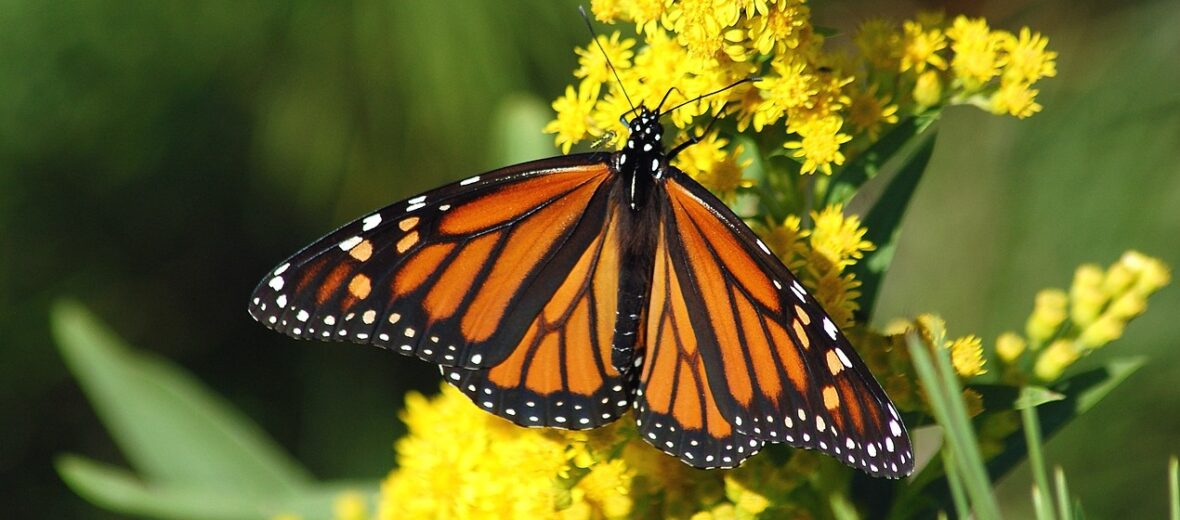
Every year, during the fall, untold millions of monarch butterflies travel over 3,000 miles from North America to Mexico. Their journey is among the greatest migrations of any in the animal kingdom. Traveling up to 3,000 miles during 4 generations is the norm for these beautiful critters. Even though there are millions, their way of life is threatened due to habitat loss at the hands of logging. Their metamorphosis from egg to adult is like any other butterfly, but these butterflies pack a punch. The monarch butterfly is listed as Least Concern by the IUCN.
First the Stats…
Scientific name: Danaus plexippus
Wingspan: Up to 4 inches
Lifespan: Up to 6 weeks
Now on to the Facts!
1.) Monarch and viceroy butterflies engage in Müllerian mimicry in an effort to mutually co-mimic each other and warn predators of their toxicity.
2.) Like all butterflies, the surface area of a monarch’s wings are covered with thousands of tiny, colorful scales.
3.) The monarch caterpillar and adult butterfly retain the poison from the milkweed leaves in their body. This protects them from being eaten by predators.
4.) Monarch butterfly caterpillars are a voracious consumer that can gain about 2,700 times their original weight by eating leaves!
5.) The monarchs will continue to feed, fly, and reproduce throughout the U.S. and southern Canada for several generations. It’s the 4th generation of monarchs that actually find their way to Mexico in the fall.
But wait, there’s more on the monarch butterfly!
6.) Monarchs fly up to 100+ miles a day!
7.) You can tell male from female by 2 black spots on the inside surface of their hind wings.
Did you know…?
A single female monarch can lay around 300 – 500 eggs in the wild. While captive monarchs average about 700 eggs per female over 2 – 5 weeks of laying. The record is 1,179 eggs laid in captivity!
8.) Female monarch butterflies lay tiny eggs covered with a sticky substance on the underside of milkweed leaves, which are highly toxic.
9.) The caterpillar hatches from their egg several days after it’s laid and survives on milkweed leaves.
10.) Monarchs that develop in the warmer months will become sexually mature in 5 days. On the flip side, migrating monarchs will emerge in reproductive diapause (suspension of reproductive development) and will not reproduce until Spring.
But wait, there’s still more on the monarch butterfly!
11.) The Monarch’s gold studded chrysalises are created by the pairing of a carotenoid pigment and a hill-like apparatus that reflects light from its peaks. They get the carotenoids from their exclusive milkweed diet.
12.) It is thought that they have gold spots on their pupae to deter predators. This is known as aposematic coloration.
13.) Monarch butterflies smell with their antennae. The nectar and water are tasted by the sensory hairs on their legs and feet.
14.) Butterflies cannot bite. They do drink through a long tongue called a proboscis that works like an eyedropper to draw up nectar. Like a retractable garden hose, their tongue coils up under the lower lip when not in use.
15.) According to folklore, early migration of the Monarch butterfly is one of the 20 signs of a tough winter ahead!
But wait, there’s even more on the monarch butterfly!
16.) Overwintering monarchs usually live 7 – 8 months compared to other generations that only live 2 – 6 weeks.
17.) Monarch development from egg to adult is completed in about 30 days.
Now a Short Monarch Butterfly Video!
Also, check out the Critter Science YouTube channel. Videos added frequently!
Want to suggest a critter for me to write about? Let me know here.



